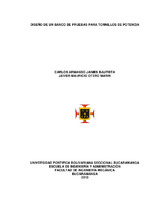| dc.contributor.advisor | Santos Jaimes, Alfonso | |
| dc.contributor.author | Jaimes Bautista, Carlos Armando | |
| dc.contributor.author | Otero Marín, Javier Mauricio | |
| dc.coverage.spatial | Seccional Bucaramanga. Universidad Pontificia Bolivariana. Escuela de Ingenierías. Facultad de Ingeniería Mecánica | spa |
| dc.coverage.temporal | 2010 | |
| dc.date.accessioned | 2013-08-28T16:59:40Z | |
| dc.date.available | 2013-08-28T16:59:40Z | |
| dc.date.created | 2010-08-09 | |
| dc.date.issued | 2013-08-28 | |
| dc.identifier.uri | http://hdl.handle.net/20.500.11912/888 | |
| dc.description | 166p.: (pdf); il; gráficas; tablas; anexos | spa |
| dc.description.abstract | Este proyecto fue creado con el objetivo de diseñar y construir un banco de prueba para tornillos de potencia, cuyo fin es el de corroborar las ecuaciones de torque de subida, torque de bajada, eficiencia mecánica y avance encontradas en los libros teóricos de diseño de elementos de maquinas, mediante el desarrollo de prácticas de laboratorio. El banco de pruebas consta de nueve tornillos de potencia de dos materiales diferentes; acero AISI 1020 y Aluminio, calculados y dibujados a través del software de CAD, Solid Works, y simulados computacionalmente con el software CAE ANSYS 12.0. Bajo estos resultados, fueron fabricados seis tornillos de potencia en AISI 1020 con diámetros de ½” y ¾”, y, tres tornillos de potencia en Aluminio con diámetro de ¾” y con rosca Acme. Junto a los tornillos fue diseñado un sistema de acople rápido que brinda dinamismo al sistema, permitiendo cambiar los diferente tornillos presentes en el banco de manera fácil y ágil; y un sistema de acople rígido (bridas), cuya labor es transmitir el torque del motor y facilitar el montaje y desmontaje del banco de pruebas. | spa |
| dc.description.abstract | This project was created with the objectives of to design and to build a test bench for power screws, which main goal is to corroborate the lift torque’s, descend torque’s, mechanical efficiency’s and advance’s equations, found in machines elements design theory books, through work out of laboratory practices. The test bench has nine power screws of two different materials; AISI 1020 steel and aluminum, calculated and designed using the CAD software, Solid Works, and digitally simulated with the CAE software ANSYS 12.0. Under these results, where build six power screws in AISI 1020 steel with diameters of ½” and ¾” , and, three power screws of aluminum with diameters of ¾”, and Acme thread. Along with the screws was designed a fast joint system that provide dynamic to the system, allowing to change in an easy and agile way the different screws in the bench; and a rigid joint system (flange), whose labor is to transmit the motor’s torque and to facilitate the mount and unmount of the test bench. | |
| dc.language.iso | es | |
| dc.publisher | Universidad Pontificia Bolivariana | spa |
| dc.rights | Attribution-NonCommercial-NoDerivatives 4.0 International | * |
| dc.rights.uri | http://creativecommons.org/licenses/by-nc-nd/4.0/ | * |
| dc.subject | Tesis y disertaciones académicas | spa |
| dc.subject | Ingeniería mecánica | spa |
| dc.subject | Tornillos | spa |
| dc.subject | Tornillos de potencia | spa |
| dc.subject | Tornillos - pruebas | spa |
| dc.title | Diseño de un banco de pruebas para tornillos de potencia | spa |
| dc.type | bacherlorThesis | spa |
| dc.rights.accessRights | openAccess | spa |
| dc.type.hasVersion | publishedVersion | spa |
| dc.identifier.instname | instname:Universidad Pontificia Bolivariana | spa |
| dc.identifier.reponame | reponame:Repositorio Institucional de la Universidad Pontificia Bolivariana | spa |
| dc.identifier.repourl | repourl:https://repository.unab.edu.co/ | |


